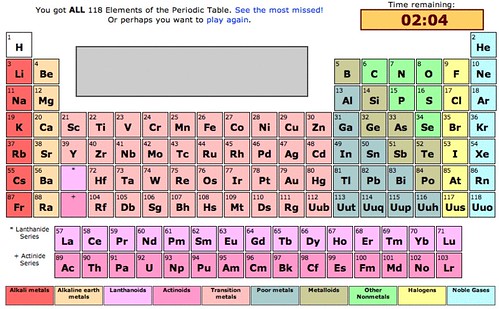The first time I tried the
Peridodic Table game (I saw it on Digg or Reddit or something of that ilk), I only managed 51 of the 118 (well,
117, depending).
(Note: Adamantium, Vibranium, Unobtanium, and Neutronium are not actually elements.)
Tom Lehrer's Elements Song was not of particular help to me (and in fact, may have hindered my efforts, since I could only remember the tune and not the words). Though to be fair,
the song was done in 1959, when there were 15 fewer elements.
Anyway, I took it as something of a challenge. The fact that playing the game enabled procrastination in
discrete 15 minute intervals may have contributed to things.
I finally managed all 118 elements in 15 minutes yesterday:
To nail an element, you have to type its full name, not its symbol, though it accepts standard spellings in addition to the "English" variations (i.e. aluminium vs. aluminum).
My mnemonic strategies varied. Of course, none of them are useful for anything except completing this particular quiz.
You have to start with hydrogen, of course, and it's easy to stay within the order of increasing atomic number at the beginning: helium, lithium, beryllium, [Boron: I left out boron. Dammit.] carbon, nitrogen, oxygen.
Fluorine is memorable, if only for its spelling -- my chemistry teacher used to say, "It's fluorine, not 'flo-urine.'" After that, it's the noble gases -- neon, argon, krypton, xenon (think headlights), and radon.
Initially, I had no idea what to do with the elements above atomic number 111, but they all have temporary names that stick to a very simple convention: unun[numerical prefix]ium, so if you can remember one (say, ununpentium), that's basically 7 elements right there (just remember that 116 is ununhexium, not ununsexium).
After that, it becomes a little hit or miss for me. The halogen group isn't bad -- we already have fluorine, so chlorine, bromine, and iodine fall in pretty easily. Although what the hell is astatine? No idea, but that kind of leads into some other odd ones, like arsenic and antimony.
Chlorine is part of salt, as is sodium, which jumps us back to the alkali metals, like potassium. Rubidium gave me problems until I looked it up and saw that it was named for its ruby-reddish properties. Then there's cesium (used in atomic clocks) and barium (used in diagnostic enemas), then francium.
Francium leads us to places elements -- germanium, polonium (which is also used to
kill dissidents, as is thallium), europium. Rhodium isn't named for Rhodesia or Rhode Island, nor is Indium named for India or Indiana, but whatever. Then there's the National Labs in California -- californium, berkelium, lawrencium -- and americium.
Although we dipped into the Lanthanide series (lanthanum) and the Actinide series (actinium and protactinium), let's go back to the metals everyone knows: gold, silver, platinum, iron, tin, mercury, magnesium (and manganese), nickel, zinc, aluminum, titanium, lead (and bismuth, for some reason).
If you know bike frames, you'll know chrome-moly (chromium and molybdenum [which is not pronounced "molly-bee-denim"), then other elements used in common alloys: vanadium, scandium, tantalum, zirconium.
Niobium is used in anodized rainbow-colored body jewelry (ask me how I know this).
Tungsten is used in light bulb filaments and anti-tank rounds; palladium was used in cold fusion; osmium I know from a
comic book (it was used to make denser-than-usual barbell weights for superhumans); cadmium was used in paint pigments, as well as to dampen nuclear reactions.
Speaking of, you can't forget the other radioactives -- uranium and plutonium. Then there's the various isotopes of cobalt, thorium, and strontium that pop up in all sorts of sci-fi, from Isaac Asimov to
Beneath the Planet of the Apes to
Judge Dredd; technetium has a root of
techne; rhenium is "Rhine," so it's back to places; but then you go to ruthenium, which isn't named for Babe Ruth (but could be); while we're back to people we can go headlong back into the Actinide and Lanthanide series: curium (Marie Curie worked with radium), einsteinium, bohrium, mendelevium, nobelium, roentgenium, seaborgium (resistance is futile), meitnerium (reminded me of a guy I knew in college, Scott Mitzner), fermium, rutherfordium, gadolinium (yes, I used James Gandolfini as a mnemonic device), hassium (yes, I realize that it wasn't named for
David Hasselhoff, though while we're here we might as well take care of hafnium); dubnium (which, also, is not named for Dubya); tellurium (not named for
Edward Teller).
It starts to get ugly here. Neodymium (
not "neodynium") is used in speakers, which is kind of related to praseodymium; cerium for the asteroid/minor planet/Roman god Ceres, leading to neptunium for the planet/god and promethium; samarium (kind of a good Samaritan); back to places in Scandanavia with ytterbium (and as we hit the Y's, think yttrium), terbium, erbium, holmium (think Stockholm); and thulium (think Ultima Thule).
So where does that leave us? Some nonstandard names: phosphorous, sulfur, silicon. Silicon is used in semiconductor chips, as is gallium. Minerals you find in vitamins: selenium, calcium. Lutetium, for the lute. Darmstadtium is technically derived from a place, though it's easier to think "darn" and go form there. And dysprosium you just have to know.
I think that covers it. Did I miss anything?
Labels: dumb things, science


